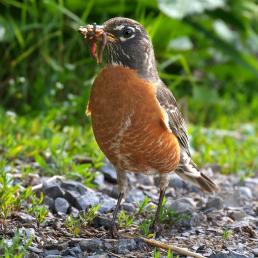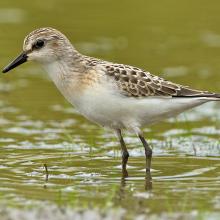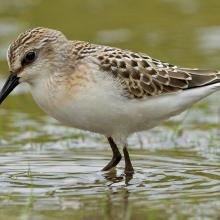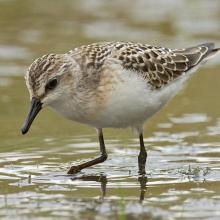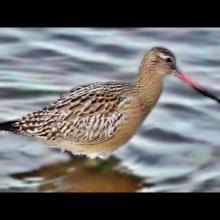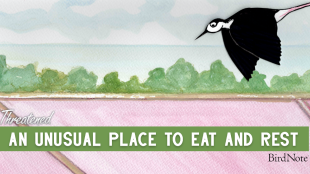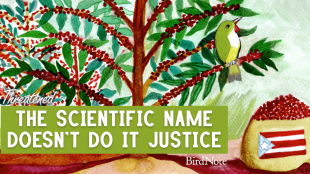

Join BirdNote tomorrow, November 30th!
Illustrator David Sibley and actor H. Jon Benjamin will face off in the bird illustration battle of the century during BirdNote's Year-end Celebration and Auction!
In this bonus episode of Threatened, Ari Daniel and Scott Weidensaul, author of A World on the Wing, discuss the incredible abilities of migratory birds, the challenges they face in a rapidly changing world, and what we can do to help alleviate the pressure.
[BirdNote Presents Stinger]
[Threatened Theme starts]
Ari Daniel: Hey everyone, it's Ari Daniel here, with a special bonus episode of Threatened. We're trying something a little different. Typically, we head to a specific place where birds need our help — and we will hear about a few places like that — but today we're focusing on migration, one of the most remarkable and mysterious aspects of many birds’ life cycles.
[Threatened Theme swells]
Writer and researcher Scott Weidensaul is an expert on migration. In his new book, A World on the Wing: The Global Odyssey of Migratory Birds, he gets into their amazing feats of migration and the new technologies giving us insights into how they make their global journeys. Scott also explores the threats facing migratory birds today and what we can do to support them. I got to attend a talk Scott gave at the Willistown Conservation Trust, on the outskirts of Philadelphia. Afterwards, out under the night sky, we sat down for a chat — you'll be hearing from both of these recordings during today's episode. Let's dive in — and we'll start with some of the remarkable physiological adaptations that allow birds to survive their demanding treks.
Scott Weidensaul: Every time I hear them compared to human athletes, I get kind of annoyed for the birds’ sake. Because they outstrip even the most elite human athlete.
Like for example, a Semipalmated Sandpiper is a tiny little bird, six inches long, weighs slightly more than an ounce. And the Semipalmated Sandpipers that breed in the Central and Eastern Canadian Arctic make a 3,300 mile nonstop flight from the northeastern coast of North America, across the Western Atlantic, to the northeastern coast of South America, where they spend the winter. That is the equivalent of a human being running 126 consecutive marathons and doing it without any food or water or rest. It's a four or five day continuous flight. If they stop beating their wings for even a minute or so, they're going to be plunked down in the ocean and die.
Ari Daniel: And migrating birds aren't just these stellar athletes — they also have a whole host of senses that we can't even dream of. One that’s particularly captivating for Scott is how birds "see" earth's magnetic field. As a bird is migrating through the night sky…
Scott Weidensaul: A photon of blue light that was emitted from a star 10 million lightyears away comes hurtling through the night, hits the eye. And in the eye, it strikes a pigment molecule called cryptochrome. And it knocks an electron out of that cryptochrome molecule and into an adjacent cryptochrome molecule. They now have an unequal number of electrons and they are in quantum terms, a radical pair. They are quantumly entangled. And for this brief milli- milli- milli- millisecond, they are also magnetised. So you have a pigment molecule that is sensitive to the Earth's magnetic field. So as this bird is flying north it can actually see the magnetic field that's emanating out of the Earth's core.
Ari Daniel: What do you imagine it's like to be a bird using the landscape, using the stars, what do you imagine that to be like?
Scott Weidensaul: I wish I knew. God, I wish I knew. The night must be alive with sensory aspects that we can't even comprehend. To look at the night sky and be able to see the apparent movement of the stars so that you know what part of the sky is not moving. They can hear extremely low frequency sound waves that can travel halfway around the world, generated by ocean surf and tectonic activity. Seabirds can smell their way across oceans. What that looks like, how that feels? I don't know.
And we keep peeling back layers of how they do this. I mean, every time we answer one of these questions, like what's this visual magnetic sense that we know birds have, we uncover some other mystery.
Ari Daniel: And they're so tiny. All of that packed into such a tiny little thing.
Scott Weidensaul: Oh yeah. Yeah. I mean, a two and a half gram hummingbird that weighs about as much as a nickel, Ruby-throated Hummingbird flying 600 miles nonstop across the Gulf of Mexico twice a year. With a brain, the size of tic-tac and, and able to remember the routes that it follows and the places, you know, all the little stops along the way between the Canadian Maritimes and the Highlands of Northern Nicaragua, where it's going to winter in a shade coffee farm. Um, and I can't remember where I put my keys this morning, you know, it's just, it's so, it's so damned humbling.
Ari Daniel: Um, you talked about the athleticism of some of these birds, um, and to me to think about a year spent almost half of it in the air constantly moving sounds exhausting. Um, so like, why, why go to all this trouble?
Scott Weidensaul: Because it's worth it for them. You know, people say: well god, why don't they just stay in the jungle? Well, because, the tropics are a lousy place to raise your babies, there's snakes and monkeys.
And then the Northern Hemisphere is where most of the landmass is. You've got long, in some cases, perpetual sunlight during the summertime. A tremendous amount of food for insect eating birds. My god, have you ever been in the mosquito zone in Alaska or the boreal forest? There's lots of food!
Ari Daniel: These migratory patterns didn't just happen — they developed over long periods of time. Including at the end of the last Ice Age.
Scott Weidensaul: When the continental ice sheets retreat to the north, and it opens up all that land in the Northern Hemisphere, these birds that during the peak of the ice age had been pushed far to the south, into refugia in what's now the tropics. Every year, they go a little farther, and a little farther and a little farther north, year after year, decade after decade millennia, after millennia, recolonizing these areas to the north and their migration routes get longer and longer and longer. And then they head back south again, every fall. And we can actually see this with some species of birds that are still moving into new areas and still colonizing new places, a little farther every year.
Ari Daniel: It sounds like maybe what you're describing is a theory as to how birds could develop such a geographic understanding of the planet, to know where they need to fly. Kind of gradually building it up over generations.
Scott Weidensaul: Exactly. They don't just get up one morning and go: you know, I've heard Guatemala is nice this time of the year.
Ari Daniel: Migrations are certainly not a vacation — they're the most dangerous part of a bird's life cycle — but for a number of reasons, they're getting even harder. As Scott just explained, birds have developed their migratory patterns over many many generations, a slow evolution. But with climate change, weather patterns across the globe are shifting rapidly, altering the seasons and cycles that the birds have come to depend upon during migration.
Scott Weidensaul: It's the part of their life cycle, where they are most delicately balanced between distance and time and energy output and resources, and predictable weather and predictable wind patterns. they're right on the edge. And the thing that worries me the most is that the longest, most dramatic, most epic migrations are the ones that are at the most immediate risk because they're the ones where there's just no margin for error. You know, if you're a Bar-tailed Godwit flying from Alaska to New Zealand over the course of 11 days, you know, they only can do that because when they take off from Alaska, they wait for the passage of, you know, these big Aleutian gales with a a hundred mile an hour winds. And they wait for those winds to shift so that they're a tailwind. And then it gets slingshotted out into the Pacific Ocean. Well, if those weather systems change, they lose that, that prevailing tailwind that's going to help them over the first couple of thousand miles of their trip. So, can they make it without that? I don't know.
Ari Daniel: Phenology is the timing of nature, like when plants bloom, or when birds return in the spring. And some long-term phenology data have actually shown some species adapting to the changing climate.
Scott Weidensaul: Many species of migratory birds are arriving up to two weeks earlier in the spring and leaving weeks later in the fall. Which is obviously an encouraging thought. They're showing some plasticity, but if you look a little bit closer at those data, you see that the birds that are making those changes, the birds that are showing up earlier, are for the most part species that winter within the United States,
On the other hand, long distance migrants wintering in Southern Mexico, Central America, the Caribbean, Northern South America — they have no idea what the weather is like up here in the north. And so they're coming back, on average to the day, when they did a century ago. But spring is getting earlier and earlier every year. So these birds fall farther and farther out of sync with the seasons.
Ari Daniel: And falling out of sync can be devastating to that finely tuned balancing act.
Scott Weidensaul: The folks at Cornell have been doing some, some modeling, looking at how, under, under changing climate conditions, how weather and wind patterns are going to change at different times of the year.
depending on what, what their migration route is and the timing, the winds at certain times of their migration cycle may become more favourable. Others will be less favorable. And there's going to be winners and losers. By the end of the century, virtually every North American migrant at every point of its annual cycle, the, the, the climate conditions are going to have changed significantly. And that's extraordinarily rapid change.
Maybe the birds can adapt to that, but they're also already dealing with challenges of habitat loss and chemical contamination and windows and cats and you know, all these other things. And it just terrifies me to think of them, you know, trying to, trying to climb yet one more big hurdle at a time when they've got so many other hurdles to overcome.
Ari Daniel: Beyond climate change, there's the issue of habitat loss, as Scott mentions. For many birds, they depend on key stopover sites and habitats that are increasingly threatened. In North America, the birds in the biggest trouble are grassland birds, like meadowlarks, and Grasshopper Sparrows.
Scott Weidensaul: And that's not a mystery. We've destroyed or altered almost all of the natural grasslands, especially here in Eastern North America.
Ari Daniel: But in looking at how birds in different habitats have fared, Scott says there's a roadmap for recovery.
Scott Weidensaul: Look at what happened to wetland birds over the last 50 years. Their numbers have rebounded dramatically. Waterfowl like ducks and geese and swans, wading birds like herons and egrets and ibis, um, secretive marshland birds like rails. And the reason for that is not a mystery. Starting in the 1980s, when duck populations cratered because of drought and, and habitat loss, we, as a society began pouring an enormous amount of, of time and effort and political will and money into restoring and enhancing and protecting wetland habitats. And if you build it, the birds will come. And these birds came back dramatically. There is absolutely no reason why we can't do the same thing for grassland birds here in North America, the group that's in the worst trouble. Their problem is primarily one of habitat. And if we put the same effort and time and political will and resources into restoring and enhancing grassland habitats, we can bring these birds back.
Ari Daniel: In Threatened style, let's focus for a moment on a specific stopover habitat that's vital for migratory birds. Millions of migrating shorebirds, songbirds, waterfowl and raptors depend every year on the Yellow Sea between China and the Korean peninsula.
Scott Weidensaul: And it is also one of the most critically endangered migratory stop points anywhere in the world. And the reason for that is because the mud flats on which these birds depend have proven to be commercially valuable. Now you have to understand, the mud flats on the Yellow Sea are the largest in the world. When the tide goes out here, it goes out for like 20 kilometers. It's mind bogglingly big. And when you look at the mud, it looks completely lifeless. But when you dig under the surface, it's this buffet of marine invertebrates, polychaete worms, tiny little mollusks. But particularly China and South Korea have destroyed now about 70% of the tidal flats along the Yellow Sea. They've walled them off with sea walls, filled it in with sediment, turned it into dry land for industrial sites or cities, or deep water aquaculture ponds for fish and shrimp and jellyfish, which are too deep for the shorebirds to use.
For every additional acre of mudflat that is destroyed, birds disappear. Birds die. When South Korea built a 21 mile long seawall that blocked the tide from 150 square miles of what used to be fertile tidal flats on which a fifth of the world's Great Knots depended, a fifth of the world's Great Knots disappeared. They didn't go somewhere else. There was nowhere else for them to go. They died.
Ari Daniel: But conservationists like Jing Li from within China and scientists like Theunis Piersma have been fighting on behalf of the birds.
Scott Weidensaul: They've been lobbying the Chinese government for years to save what was left of the Yellow Sea. When I visited there in the spring of 2018, just a few months before that trip, to everybody's shock and amazement, the Chinese government did exactly that. They issued a sweeping ban on all further coastal reclamation, as it's called, coastal destruction, along the Yellow Sea. And so during my time there, I found Jing and Theunis and other conservationists grappling with a very unfamiliar emotion: hope.
Ari Daniel: Wins like this one are what we need not just to save the birds, but to keep our planet safe for people and really, all living creatures.
Ari Daniel: So I'm wondering what, what does bird migration have to teach us?
Scott Weidensaul: The absolute interconnectivity of every part of this planet. Even the great weather systems, you know, that come roaring out of the poles, but kind of fizzle at the equator, do not connect the world as uniformly and completely as bird migration does.
With the exception of, like, the Central Antarctic Plateau, there are species of birds covering every square kilometer of this planet. And so, if we can figure out how to make this planet safe for them, we've got it made.
Ari Daniel: And while the challenges migratory birds are facing are greater than they've ever been, we've also made breakthroughs to understand how we can combat these issues. More on that, after the break.
~MIDROLL~
Ari Daniel: Birds are facing unprecedented challenges to their already tough migrations — they're the most difficult feat of a migrating bird's life cycle. But they're also the most mysterious parts of these birds' lives. It's really hard to follow birds along a route that might be as long as 60 thousand miles! Recently, though, there’ve been a number of advances that are helping unravel the mysteries of migration.
Scott Weidensaul: The miniaturization, particularly miniaturization of batteries has really revolutionized bird tracking technology. We have things like, light sensitive geolocators, which are tiny little devices with a microprocessor and a clock and a memory bank and a little light sensor. And all they do is record light levels, 24 hours a day. So, you know, the moment of sunrise and the moment of sunset, the time and, and local, local noon, you can figure out the latitude and longitude within like plus or minus 120 miles. But if it's a bird like an Arctic Tern flying from Maine to the Indian Ocean and back again, that's enough.
There are tiny little GPS pinpoint tags that will turn themselves on, get a fix from the GPS satellites overhead, log that location and turn themselves back off again. And then at a preset interval, turn back on again. And so you can pre-program, depending on the size of the unit, 10, 15, 20, 50 locations, and you won't get every point where that bird's been, but the points you get, you can tell it was in this tree and not that tree.
Ari Daniel: But perhaps the most remarkable innovation is the Motus Wildlife Tracking System spearheaded by BirdsCanada and now spreading around the world. There’s a Motus station here at the Willistown Conservation Trust, it’s part of their Bird Conservation Program. Looking at it, you might think it’s just a big old school TV antenna that no one’s gotten around to taking down. But the station’s tracking small radio transmitters that have been placed on birds. And a global network of hundreds of these receiver stations, including the one here, listen for the transmitters and log them when they pass by. Which lets you do a lot of counting. And let me be clear, these transmitters are REALLY small.
Scott Weidensaul: I mean, literally tiny enough to put on a Monarch Butterfly, much less a bird, all sending out an individual identification code and with this growing network, for the first time, we're able to track even the smallest migrant birds across landscape or hemisphere distances, which is huge. Because if we're going to have a prayer of reversing the declines and restoring the birds that we've lost over the past decades, we're going to need to know every part of their annual cycle and where the dangers lie.
Ari Daniel: Another technology is one that wasn't created for the birds — it's doppler weather radar, which, it turns out, can be used to track huge flocks of birds on the move.
Scott Weidensaul: You know, we're sitting outside right now at night on a, on an evening when there are literally hundreds of millions of birds, migrating across North America in the darkness, you know, thousands of feet overhead right now. I could, I could pull this up on radar and show you right now what's going on overhead.
Ari Daniel: You're just opening your phone?
Scott Weidensaul: I'm just opening up my phone and I'm going to pull up the doppler radar… Those are all birds, that huge blob of green is probably several million migrants.
Ari Daniel: So these are birds that are overhead right now. Of course we can't see them. How far up are they?
Scott Weidensaul: We used to think that most birds migrating at night were migrating within 500 to 2000 feet of the ground. But more recently we've discovered that in some, in some cases, the birds are flying up as much as eight or 10,000 feet up there. Just layers and layers and layers of birds.
Ari Daniel: So you can census birds this way?
Scott Weidensaul: Yeah. And in fact, um, the BirdCast website that Cornell has, that is taking real time radar data from all 143 radar sites across the lower 48 and the, you know, the computing power now is so great that it can take that every 10 minutes scan from every one of those, calculate the number of birds per cubic meter of airspace up there. And if I go to BirdCast right now. You can see that the prediction for tonight is extremely high migration in, in Eastern North America, where we are right now. And if I go to the live map, as of right now, there are 265.9 million birds in flight over Eastern North America. You can, you can see the of the migration, particularly, um, east of the Mississippi River.
Ari Daniel: We also have crowd-sourced information from tools like eBird, a website and app where people log the birds they see in their backyards, in parks or outside their office window. And when you combine all of these technologies, you start to get a pretty clear picture of all parts of bird migration. The doppler radar gives an incredible, real-time view of birds coursing above the continent. Cross-referencing that with eBird can tell you which bird species are in each of those giant masses. Adding in the Motus data provides further resolution to bird movements, with pinpoint precision from a special few birds fitted with GPS trackers.
And all this is super important because understanding migration is crucial for conservation. Because...
Ari Daniel: Where are they going? Are they flying south now?
Scott Weidensaul: Mhm! Yep. And in fact, the radar will show you the direction in which those birds are flying.
Ari Daniel: They're not just going "south." Yes, southward, but to where exactly? For a long time, for so many species, we didn't know which specific habitats they use on their wintering grounds, let alone the route they take to get there. Ascertaining these fine details, through new technologies, has proven to be tremendously important.
Scott Weidensaul: We need to figure out ways — and this is where the new tracking technology is coming in, just in the nick of time — to understand the full annual cycles of these birds. Even their full daily cycles.
Whimbrels, these beautiful big duck-sized shorebirds with long, curved bills probably the single most important habitat for them are nocturnal roosts. There's a place called Deveaux Bank off Charleston, off the North Edisto River, where 20,000 Whimbrels, a quarter of all the whimbrels in the Western hemisphere, gather every night in May on their migration because there's no other place far enough offshore to get away from predators and high enough above the tide that, even at astronomical high tides, they've got a safe place to sit and it turns out there's virtually no other place along the whole Southeastern coast where they can find that. And, we didn't know that until just a couple of years ago. That may be one of the most important things that we can do for migrant shorebirds, is create more of those nocturnal roosts along the Southeastern coast. But because we didn't understand their full daily cycle, we didn't know that.
Ari Daniel: Even birds ornithologists thought they understood are turning out to have far more complex behaviors and movements than we imagined.
Scott Weidensaul: We're finding that the more we look at birds, their dependence on the landscape is far more complicated than we thought. Back in the 1980s, when we first became aware of the dangers of forest fragmentation and the risks that they pose to species like Wood Thrushes and Scarlet Tanagers, that breed deep in the interiors of contiguous forest. We thought, okay, what we need to do is prevent forest fragmentation and preserve big blocks of contiguous older forest, and not that we shouldn't do that, but it turns out that those same birds, like Wood Thrushes, once their babies leave the nest, which is a time when it's really hard to track them. If you actually go to the hard work of tracking those birds, they move into early successional forests. Like, old clear cuts that are regenerating into thickets, which nobody knew these birds did, because they're using multiple habitats at different times in their annual cycle.
Ari Daniel: And there are places where these data are leading directly to conservation action. The Central Valley of California is a linchpin of the Pacific Flyway that many species depend upon. But it's also great agricultural land, and has mostly been developed for farming, with strong financial incentives to keep it that way.
Scott Weidensaul: So the scientists realized that they could take eBird data that told them what species of shorebirds were passing through exactly at what time and in what places, and combine that with high resolution satellite imagery from NASA that showed surface water conditions. And they could pay farmers relatively small amounts of money to flood their rice fields at just the right time, to just the right depth for just long enough to create tens of thousands of acres of what they call pop-up wetlands that the birds use. And then they leave and then the wetlands go away until the next year.
Ari Daniel: Another big issue for migrating birds is light pollution. As they pass near cities, birds get drawn in and confused by bright city lights, throwing them off course or leading to window collisions. But now it’s possible to create a targeted real-time response.
Scott Weidensaul: We know, from radar data, that within any given urban area, the majority of the migration is going to pass over just a couple of nights in the spring and a couple of nights in the fall. Okay. So those are the nights that we target people to turn their lights out.
Ari Daniel: What do you think the future holds? You know, I mean, I feel like, I feel like you outlined a couple of scenarios in which things improved quickly if we get our act together. But we're not a species known for getting our act together.
Scott Weidensaul: No, we're not.
Ari Daniel: But you know, you also mentioned that birds, these migratory birds could capture the imaginations of people at a time when we need to believe in something.
Scott Weidensaul: And through the pandemic, an awful lot of people who'd never paid any attention to birds before have become aware of them. I think we have a generational opportunity right now in this immediate wake of the pandemic to grab those people with both hands and say, okay, birds got you through the lockdown last year, looking out your window at this pageant going through your backyard gave you hope at a time when you needed it.
Okay. Now the birds need you. And in the process, you can continue to open your eyes to this astonishing world around you that's going to give you joy and delight and, and excitement for the rest of your lives. That's not a bad deal. Birds need every friend they can get right now.
The fact is, you know, some days I'm as depressed as anybody else at how things go. I mean, I have my up days and my down days, but I take a great deal of comfort in the demonstrated resiliency of nature and especially the demonstrated resiliency of birds. When I was a kid, seeing a single Bald Eagle migrating down the Kittatinny Ridge was a big deal. I mean, the year I graduated from high school in 1976, the grand total count at Hawk Mountain in Pennsylvania was 24 Bald Eagles. They have some hours when we count 24 bald Eagles up there now. The number of wild turkeys in the state of Maine is 810,000% what it was in 1970. You know, not every bird is going to respond that well, you know, Bald Eagles and Peregrine Falcons, and Ospreys. , it was a single chemical that we were able to deal with in the form of DDT. The challenges are big and wide, but I don't ever count birds out. They have a resiliency and a tenacity that frankly we don't deserve. And I think if we give them half a chance, they'll, they'll do their part.
[Threatened Theme]
Ari Daniel: Thanks to Scott Weidensaul for spending today's episode with us. His new book, A World on the Wing: The Global Odyssey of Migratory Birds, is out now. It's full of so much more on migration, including, get this, how Bar-tailed Godwits shrink some of their organs before migrating to save weight, then regrow those organs once they arrive. You can find links to Scott’s book, and lots more stories about migration, at our website, BirdNote.org.
Today’s episode was produced by Allison Wilson, Mark Bramhill, Conor Gearin, Sam Johnson, and me, Ari Daniel. Fact checking by Conor Gearin, mixing by John Kessler. Original theme music by Ian Coss.
Special thanks to Willistown Conservation Trust.
I'm Ari Daniel — until next time.
Threatened is a production of BirdNote. Learn more about the BirdNote team.
Love this podcast? Support BirdNote today!
